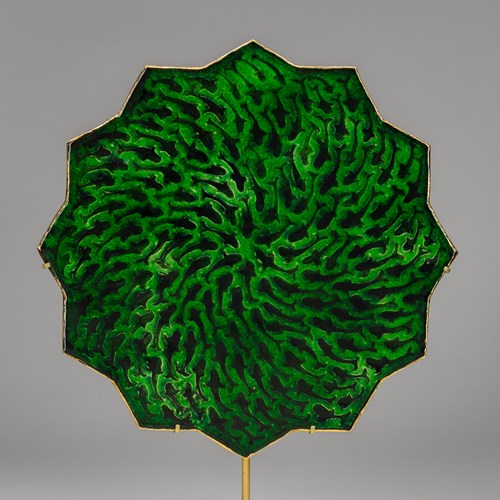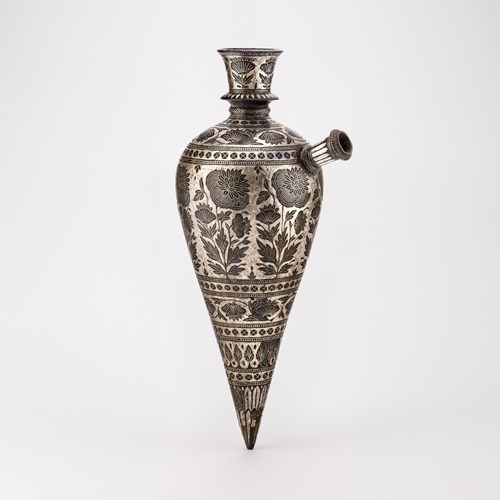Marketplace
Mughal Jade Bowl
The first jade objects in Islamic lands were made when the Chaghtais lost the jade mines of Khotan on the Southern Silk Road, in today's Xinjiang autonomous region, China, to the Timurids.1 Jade was valued not only for its cool, silky texture, but for the manhours needed to fashion it; jade cannot be worked by chipping, but only by time-consuming abrasion.2 Surviving Timurid jades are inscribed with names of members of the family, suggesting royal associations.3 The enthusiasm for jade was exported to India with the invasion and subsequent foundation of the Mughal Empire by Babur, a Central Asian prince and descendant of Timur. By the reign of the fifth Mughal Emperor, Shah Jahan (r. 1628-1658), a recognisable Mughal jade style had been established.4 Distinctive not only for its purity and thinness, for which it was praised by the Chinese emperor Qianlong, Mughal jade may be recognised for its floral ornamentation.5 The influence of both Persian painting and European botanical studies resulted in the movement known as “floral naturalism”, which pervaded almost every art form by the reign of Shah Jahan.6 The large collection of Mughal jade preserved in the National Palace Museum in Taipei, Taiwan, displays an excellent variety of bowls with lotus handles, poppy and chrysanthemum bases, and carved leaf and flower ornamentation.7
Of grey-green colour and translucent when held up to the light, this unusually large oval bowl is carved from a single piece of jade. Two openwork acanthus leaf handles transform the eight-lobed vessel into a flower. It stands on an octofoil poppy foot, at the centre of which is a hatched star. It closely resembles a bowl belonging to the Metropolitan Museum of Art, with eight lobes and acanthus handles (accession no. 02.18.756), dating to the 17th century. A 12-sided jade bowl dating to the mid-17th century with lotus bud handles is in the collection of the Victoria and Albert Museum (accession no. IS.25-1997), alongside a late 17th or early 18th century salver containing a carved flower, the detail of which resembles the flower on the bowl above (accession no. 765-1903).
n.b. accession nos are clickable links
1 Blair, Sheila S. ‘Timurid Signs of Sovereignty’, Oriente Moderno 76.2 (1996). pp. 551-576, 569.
2 Sax, Margaret et al. ‘The identification of carving techniques on Chinese jade’, Journal of Archaeological Science 31.10 (2004). pp. 1413-1428.
3 Ibid. p. 570.
4 Stronge, Susan. The Indian Heritage: Court Life Under Mughal Rule. London: Victoria & Albert Museum, 1982. P. 105.
5 Teng Shu-ping 鄧淑蘋. Exquisite Beauty – Islamic Jades國色天香: 伊斯蘭玉器. Taipei: National Palace Museum, 2008. P. 54.
6 Ibid. p. 105; Skelton, Robert. ‘A Decorative Motif in Mughal Art’, in Pratapaditya Pal (ed.) Aspects of Indian Art: Papers Presented in a Symposium at the Los Angeles County Museum of Art, October 1970. Leiden: 1972. Pp. 147-52.
7 Teng Shu-ping 鄧淑蘋. Op. cit. no.47, no.58, no.59.
Of grey-green colour and translucent when held up to the light, this unusually large oval bowl is carved from a single piece of jade. Two openwork acanthus leaf handles transform the eight-lobed vessel into a flower. It stands on an octofoil poppy foot, at the centre of which is a hatched star. It closely resembles a bowl belonging to the Metropolitan Museum of Art, with eight lobes and acanthus handles (accession no. 02.18.756), dating to the 17th century. A 12-sided jade bowl dating to the mid-17th century with lotus bud handles is in the collection of the Victoria and Albert Museum (accession no. IS.25-1997), alongside a late 17th or early 18th century salver containing a carved flower, the detail of which resembles the flower on the bowl above (accession no. 765-1903).
n.b. accession nos are clickable links
1 Blair, Sheila S. ‘Timurid Signs of Sovereignty’, Oriente Moderno 76.2 (1996). pp. 551-576, 569.
2 Sax, Margaret et al. ‘The identification of carving techniques on Chinese jade’, Journal of Archaeological Science 31.10 (2004). pp. 1413-1428.
3 Ibid. p. 570.
4 Stronge, Susan. The Indian Heritage: Court Life Under Mughal Rule. London: Victoria & Albert Museum, 1982. P. 105.
5 Teng Shu-ping 鄧淑蘋. Exquisite Beauty – Islamic Jades國色天香: 伊斯蘭玉器. Taipei: National Palace Museum, 2008. P. 54.
6 Ibid. p. 105; Skelton, Robert. ‘A Decorative Motif in Mughal Art’, in Pratapaditya Pal (ed.) Aspects of Indian Art: Papers Presented in a Symposium at the Los Angeles County Museum of Art, October 1970. Leiden: 1972. Pp. 147-52.
7 Teng Shu-ping 鄧淑蘋. Op. cit. no.47, no.58, no.59.
Plus d'œuvres d'art de la Galerie









_T638447285695169442.jpg?width=500&height=500&mode=pad&scale=both&qlt=90&format=jpg)